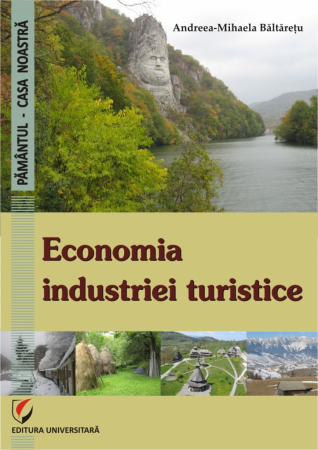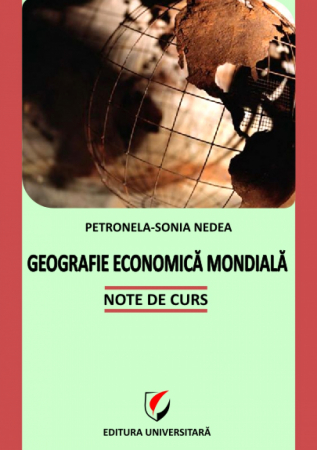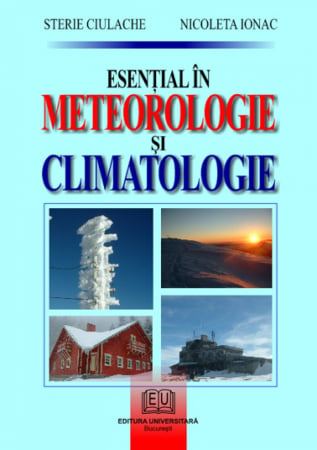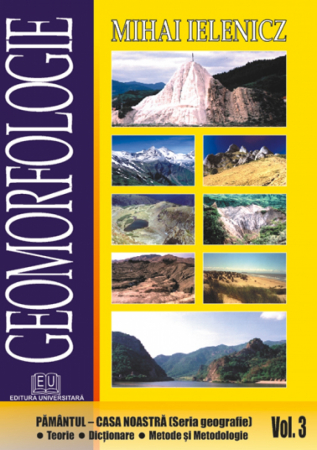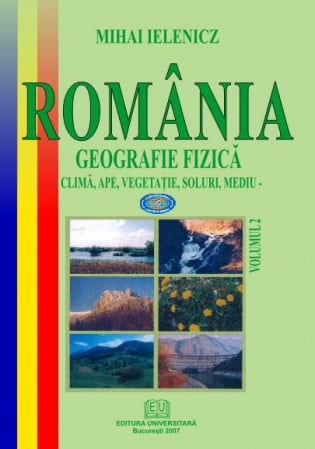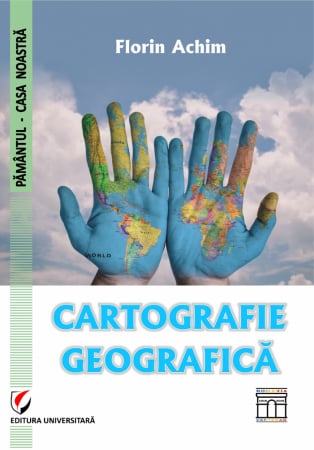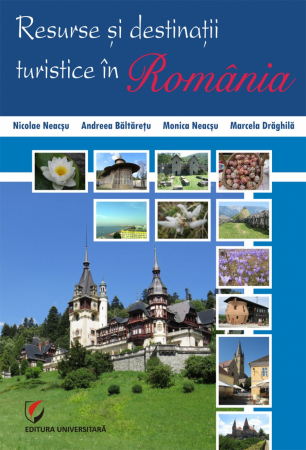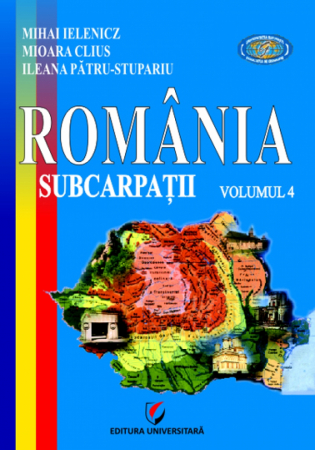ISBN: 978-606-591-352-3
DOI: 10.5682/9786065913523
Publisher year: 2012
Edition: I
Pages: 412
Publisher: Editura Universitară
Author: Vasile Popa
- Description
- Download (1)
- Authors
- Content
- More details
- Reviews (0)
Geographical position and boundaries of Asia. Asia is, arguably, the largest, most populous, and most geographically complex continent. On the approximately 45 million km2, there are many of the geographical extremes of the Earth: the highest altitude - Everest, the lowest point of the land - the Dead Sea, the cold pole in the permanently humanized regions - Verkhoyansk, the rain pole - Cherrapunji, the largest lake - Caspian Sea, the deepest lake - Baikal, the largest forest - Siberian taiga, the most populous country - China, the largest metropolitan area
- Tokyo, etc.
The name Asia is very old, being first used by the Greeks, more precisely by Herodotus, in the year 440 BC. Asia is more of a geographical term, a cultural-historical concept, than a unitary continent, the separation from Europe not being very clearly expressed. In fact, Europe is often seen as a peninsula of Asia, forming Eurasia together. The boundary between these two continents, agreed by most geographers, is a line that starts in the Arctic Ocean and continues with the Ural Mountains, Ural River, Caspian Sea, Caucasus Mountains, Black Sea, Bosphorus Strait, Marmara Sea, Dardanelles Strait and Sea Aegean.
The border with Africa is given by the Suez Canal, the Red Sea, the Bab-el-Mandeb Strait and the Gulf of Aden. To the south, east and north the boundaries of the continent are given the Indian, Pacific and Arctic oceans. The Bering Strait, 85 km wide and 30-50 m deep, separates Asia from North America, and the great Arafura and Timor separate it from Australia.
Depending on the generally accepted geographical limits, we find some discrepancies with the political boundaries. In this context, we identify several transcontinental states, such as: Russia, Kazakhstan, Azerbaijan, Georgia, Turkey, Cyprus, Egypt or Indonesia. In the case of Russia, even if historically, culturally and economically it is integrated into the European space, more than 75% of the territory is east of the Ural Mountains. As for Kazakhstan, it has two provinces, Atirau and West Kazakhstan, which extend west of the Ural River. Georgia and Azerbaijan have most of the territory in Asia, but both have small portions north of the line of the highest altitudes in the Greater Caucasus. In addition, these two states, together with Armenia, have strong political, economic or cultural ties with Europe.
Turkey, despite the fact that only 3% of its territory is in Europe, has been a member of the Council of Europe since 1949 and has been the official candidate for integration into the European Union since 2005. Cyprus, an island that is geographically part of Asia, was admitted to the Council of Europe in 1961 and to the European Union in 2004.
The Sinai Peninsula, an integral part of Egypt, is located in Asia, east of the Suez Canal. In addition, geopolitically, Egypt is frequently framed by the Middle East. The island of Socotra, located off the Horn of Africa, but controlled by Yemen, as part of the Aden governorate, also has close African ties. Indonesia, commonly associated with Southeast Asia, has a number of territories that have similar characteristics to Oceania. These are the eastern provinces of the state, located beyond the Wallace Line.
If we refer only to the continental area, the extreme points of Asia are: Cape Baba (Turkey, 2604 'east longitude), Cape Dejnev (Chukotsk Peninsula, Russia, 169040' west longitude), Cape Celiuskin (Taimar Peninsula, 77043 'north latitude) , Capul Piai (Malacca Peninsula, 1016 'northern latitude). Taking into account the entire Asian space, including the island, the situation changes. Thus, the southern extremity of Asia is given by the island of Dana (Pulau Dana, 1105 'south latitude) in Indonesia, an uninhabited island located south of the island of Roti. In addition, if we consider the Cocos (Keeling) Islands as part of Southeast Asia, then the southern boundary would pass beyond the parallel of 120 south latitude.
In the same sense, the northern extremity is given by the Arctic Cape from the island of Komsomolets (Severnaia Zemlia), located at 81013 'north latitude. Then, in the central part of the Bering Strait are two islands, Diomede Mare and Mica, located at a distance of about 4 km, between which is the border between Russia and the USA and, at the same time, the International Date Line (imaginary line that designates the place where each calendar day begins). Thus, the island of Diomedes Mare, known in Russian as Ostrov Ratmanova, part of the Chukotsk district, represents the eastern extremity of Asia (169005 ').
Regions of Asia. Regarding the regionalization of Asia, even if there are some different opinions, 6 large regions can be delimited, each of them having many distinct features, besides the geographical location, such as: East Asia, Southeast Asia, South Asia, South Asia Southwest, Central Asia and North Asia.
East Asia is a region that, from a cultural-historical point of view, has been part of the sphere of influence the Chinese. The states and territories included here are: China, including the special administrative regions of Hong Kong and Macao, Japan, North Korea, South Korea, Taiwan and Mongolia. The latter, like some parts of China, which historically and culturally were not dominated by Han Chinese and have a predominantly arid environment, ie the autonomous regions of Tibet, Xinjiang Uygur and Inner Mongolia and Qinghai Province, are associated with central Asia.
East Asia is also perceived as the entire territory between India and the Amur, divided into Northeast Asia and Southeast Asia. Northeast Asia sometimes includes the land north of the Amur Valley.
Southeast Asia is the geographical region between China and India, which includes a peninsular part (Indochina Peninsula): Thailand, Vietnam, Mayanmar, Laos, Cambodia and Peninsular Malaysia, and an island: Indonesia, Philippines, East Malaysia, Singapore, Brunei and East Timor. The islands of Christmas and Cocos (Keeling), in the south of the Indonesian archipelago, are considered parts of Southeast Asia, even if they are administered by Australia.
South Asia includes the region south of the Himalayan-Hindukush mountain system, consisting of the states of India, Pakistan, Afghanistan, Bangladesh, Sri Lanka, Nepal, Bhutan and the Maldives. Some sources, such as the UN Statistics Division, include Iran in the region.
Southwest Asia corresponds to the traditional European terms of the Middle East and the Middle East, both describing the position of geographical regions in relation to Europe. These include: Turkey, Cyprus, Armenia, Georgia and Azerbaijan, countries that gravitate between Europe and Asia, but also the states of the Levant (Syria, Jordan, Lebanon and Israel), Iraq, Iran, as well as the states of the Arabian Peninsula (Saudi Arabia, Kuwait , United Arab Emirates, Oman, Yemen, Qatar and Bahrain).
Central Asia, in a modern context, includes the five former Soviet states: Kazakhstan, Uzbekistan, Turkmenistan, Tajikistan and Kyrgyzstan. In a broader sense, this includes Mongolia, Afghanistan, as well as western China (Tibet, Xinjiang Uygur and Inner Mongolia and Qinghai provinces).
North Asia, comprising the Asian part of Russia, east of the Ural Mountains, is a less used term.
-
Geografia Statelor Asiei
Download
Born in Falticeni, in 1973, where he attended the Nicu Gane Theoretical High School, Vasile Popa was admitted to the Faculty of Geography in Bucharest in 1992.
After graduation, in 1997, he continued his training in the geographical field through in-depth studies (Sustainable management of geographical landscapes through regional organization and planning) and doctoral studies.
Since 2005, he has been a doctor in geography, with the thesis Dobrogea - a space for geopolitical interferences.
He is a teacher of the Faculty of Geography, University of Bucharest, since 1999 and holder of the course Geography of Asia and Australia.
He is the author or co-author of several books and scientific articles in the field of regional geography, and in the period 2008-2011 he holds the position of scientific secretary of the Faculty of Geography.
Abbreviations / 9
EAST ASIA
China / 11
Japan / 34
North Korea / 47
South Korea / 55
Taiwan / 63
Mongolia / 70
SOUTHEAST ASIA
Indonesia / 79
Thailand / 89
Malaysia / 98
Vietnam / 106
Philippines / 116
Laos / 124
Myanmar (Burma) / 130
Cambodia / 138
Singapore / 144
Brunei / 148
East Timor / 153
SOUTH ASIA
India / 158
Pakistan / 177
Afghanistan / 188
Bangladesh / 196
Sri Lanka / 204
Nepal / 211
Bhutan / 216
Maldives / 221
SOUTHWEST ASIA
Turkey / 226
Cyprus / 238
Georgia / 242
Armenia / 250
Azerbaijan / 257
Israel / 264
Lebanon / 273
Syria / 280
Jordan / 288
Iraq / 295
Iran / 302
Saudi Arabia / 314
United Arab Emirates / 324
Oman / 330
Yemen / 337
Kuwait / 342
Qatar / 346
Bahrain / 350
CENTRAL ASIA
Kazakhstan / 356
Uzbekistan / 363
Turkmenistan / 370
Kyrgyzstan / 376
Tajikistan / 382
NORTH ASIA (Asian Russia) / 389
BIBLIOGRAPHY / 400
- Tokyo, etc.
The name Asia is very old, being first used by the Greeks, more precisely by Herodotus, in the year 440 BC. Asia is more of a geographical term, a cultural-historical concept, than a unitary continent, the separation from Europe not being very clearly expressed. In fact, Europe is often seen as a peninsula of Asia, forming Eurasia together. The boundary between these two continents, agreed by most geographers, is a line that starts in the Arctic Ocean and continues with the Ural Mountains, Ural River, Caspian Sea, Caucasus Mountains, Black Sea, Bosphorus Strait, Marmara Sea, Dardanelles Strait and Sea Aegean.
The border with Africa is given by the Suez Canal, the Red Sea, the Bab-el-Mandeb Strait and the Gulf of Aden. To the south, east and north the boundaries of the continent are given the Indian, Pacific and Arctic oceans. The Bering Strait, 85 km wide and 30-50 m deep, separates Asia from North America, and the great Arafura and Timor separate it from Australia.
Depending on the generally accepted geographical limits, we find some discrepancies with the political boundaries. In this context, we identify several transcontinental states, such as: Russia, Kazakhstan, Azerbaijan, Georgia, Turkey, Cyprus, Egypt or Indonesia. In the case of Russia, even if historically, culturally and economically it is integrated into the European space, more than 75% of the territory is east of the Ural Mountains. As for Kazakhstan, it has two provinces, Atirau and West Kazakhstan, which extend west of the Ural River. Georgia and Azerbaijan have most of the territory in Asia, but both have small portions north of the line of the highest altitudes in the Greater Caucasus. In addition, these two states, together with Armenia, have strong political, economic or cultural ties with Europe.
Turkey, despite the fact that only 3% of its territory is in Europe, has been a member of the Council of Europe since 1949 and has been the official candidate for integration into the European Union since 2005. Cyprus, an island that is geographically part of Asia, was admitted to the Council of Europe in 1961 and to the European Union in 2004.
The Sinai Peninsula, an integral part of Egypt, is located in Asia, east of the Suez Canal. In addition, geopolitically, Egypt is frequently framed by the Middle East. The island of Socotra, located off the Horn of Africa, but controlled by Yemen, as part of the Aden governorate, also has close African ties. Indonesia, commonly associated with Southeast Asia, has a number of territories that have similar characteristics to Oceania. These are the eastern provinces of the state, located beyond the Wallace Line.
If we refer only to the continental area, the extreme points of Asia are: Cape Baba (Turkey, 2604 'east longitude), Cape Dejnev (Chukotsk Peninsula, Russia, 169040' west longitude), Cape Celiuskin (Taimar Peninsula, 77043 'north latitude) , Capul Piai (Malacca Peninsula, 1016 'northern latitude). Taking into account the entire Asian space, including the island, the situation changes. Thus, the southern extremity of Asia is given by the island of Dana (Pulau Dana, 1105 'south latitude) in Indonesia, an uninhabited island located south of the island of Roti. In addition, if we consider the Cocos (Keeling) Islands as part of Southeast Asia, then the southern boundary would pass beyond the parallel of 120 south latitude.
In the same sense, the northern extremity is given by the Arctic Cape from the island of Komsomolets (Severnaia Zemlia), located at 81013 'north latitude. Then, in the central part of the Bering Strait are two islands, Diomede Mare and Mica, located at a distance of about 4 km, between which is the border between Russia and the USA and, at the same time, the International Date Line (imaginary line that designates the place where each calendar day begins). Thus, the island of Diomedes Mare, known in Russian as Ostrov Ratmanova, part of the Chukotsk district, represents the eastern extremity of Asia (169005 ').
Regions of Asia. Regarding the regionalization of Asia, even if there are some different opinions, 6 large regions can be delimited, each of them having many distinct features, besides the geographical location, such as: East Asia, Southeast Asia, South Asia, South Asia Southwest, Central Asia and North Asia.
East Asia is a region that, from a cultural-historical point of view, has been part of the sphere of influence the Chinese. The states and territories included here are: China, including the special administrative regions of Hong Kong and Macao, Japan, North Korea, South Korea, Taiwan and Mongolia. The latter, like some parts of China, which historically and culturally were not dominated by Han Chinese and have a predominantly arid environment, ie the autonomous regions of Tibet, Xinjiang Uygur and Inner Mongolia and Qinghai Province, are associated with central Asia.
East Asia is also perceived as the entire territory between India and the Amur, divided into Northeast Asia and Southeast Asia. Northeast Asia sometimes includes the land north of the Amur Valley.
Southeast Asia is the geographical region between China and India, which includes a peninsular part (Indochina Peninsula): Thailand, Vietnam, Mayanmar, Laos, Cambodia and Peninsular Malaysia, and an island: Indonesia, Philippines, East Malaysia, Singapore, Brunei and East Timor. The islands of Christmas and Cocos (Keeling), in the south of the Indonesian archipelago, are considered parts of Southeast Asia, even if they are administered by Australia.
South Asia includes the region south of the Himalayan-Hindukush mountain system, consisting of the states of India, Pakistan, Afghanistan, Bangladesh, Sri Lanka, Nepal, Bhutan and the Maldives. Some sources, such as the UN Statistics Division, include Iran in the region.
Southwest Asia corresponds to the traditional European terms of the Middle East and the Middle East, both describing the position of geographical regions in relation to Europe. These include: Turkey, Cyprus, Armenia, Georgia and Azerbaijan, countries that gravitate between Europe and Asia, but also the states of the Levant (Syria, Jordan, Lebanon and Israel), Iraq, Iran, as well as the states of the Arabian Peninsula (Saudi Arabia, Kuwait , United Arab Emirates, Oman, Yemen, Qatar and Bahrain).
Central Asia, in a modern context, includes the five former Soviet states: Kazakhstan, Uzbekistan, Turkmenistan, Tajikistan and Kyrgyzstan. In a broader sense, this includes Mongolia, Afghanistan, as well as western China (Tibet, Xinjiang Uygur and Inner Mongolia and Qinghai provinces).
North Asia, comprising the Asian part of Russia, east of the Ural Mountains, is a less used term.

6359.png)
![Geography of Asian States [1] Geography of Asian States [1]](https://gomagcdn.ro/domains/editurauniversitara.ro/files/product/large/geografia-statelor-asiei-1765-417672.jpg)

